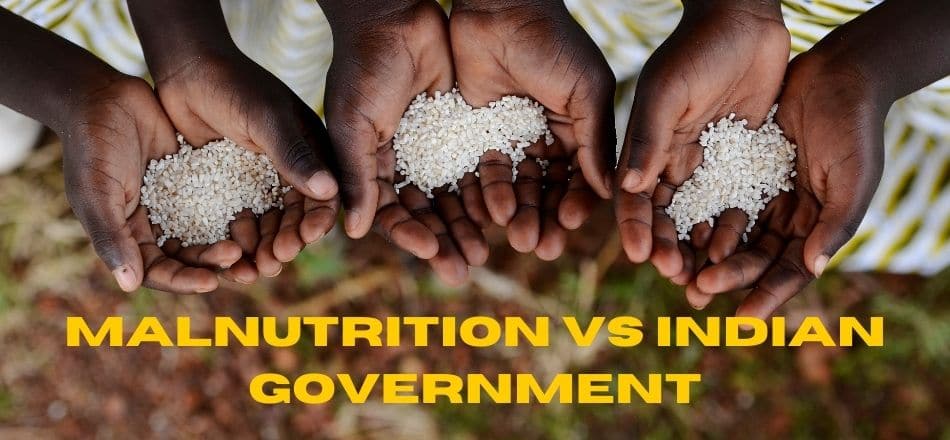The Global Hunger Index 2020 is here! India ranked at 94 in 2020, which is better than 2019’s ranking of 102.
Despite the improvement in ranking, millions of Indians struggle from malnutrition and to have a proper one-time meal, much far from a two square meal! Why is malnutrition happening? Well, the answer to that is simple! Overpopulation is the root cause of poverty but let’s not delve into that; otherwise, we would never finish this article! The more effective question to ask when the topic of malnutrition or starvation comes up would be, “What is being done to eradicate malnutrition? What can we do to prevent malnutrition?”
What is India’s plan to fight starvation and malnutrition!
The government of India is committed to eradicate starvation and fight against malnutrition. In its consistent efforts to improve the country’s nutrition status, the government of India has been launching and implementing various schemes since the last century like National Health Mission, the Mid-Day Meal Scheme, National Food Security, etc. However, with persistent measures, India’s malnutrition is still a prevalent problem that needs to be confronted more aggressively. With that view in mind, a new strategy, A National Nutrition Strategy, was released in 2017. As mentioned earlier, all of these schemes have, directly or indirectly, an aim to reduce starvation and malnutrition.
Let us talk more about the various strategies and schemes launched and implemented by the Government of India!

NATIONAL NUTRITION STRATEGY
A National Nutrition Strategy has been released to fight against malnutrition. The strategy strives to conquer all forms of malnutrition by 2030, focusing on the most vulnerable age groups. A National Nutrition Mission is under works similar to the National Health Mission. The mission will have a decentralized approach so that state, district, and local levels could take suitable and effective decisions. Strengthening nutrition initiatives taken by local bodies in urban and rural areas.
NATIONAL HEALTH MISSION (NHM)
On 1 May 2013, the National Health Mission was subdivided into two groups: National Rural Health Mission and; National Urban Health Mission. Let’s talk about them one by one.
→ NATIONAL RURAL HEALTH MISSION (NRHM)
“National Rural Health Mission(NRHM) originated on 12 April 2005 to implement accessible, affordable, and class health care to the rural people, especially the defenseless ones.”
Empowered Action Group (EAG) states, Northeastern states, and Jammu and Kashmir and Himachal Pradesh are states that have been given a special focus under this scheme,
The mission’s driving force is to establish a fully functional, community-owned, decentralized health delivery system with inter-sectoral convergence at all levels. It is to ensure that health problems such as water, sanitation, malnutrition, education, social and gender equality are fought against utilizing effective measures and actions.
→ NATIONAL URBAN HEALTH MISSION (NUHM)
The National Urban Health Mission (NUHM), on 1 May 2013, was approved by the cabinet to provide health care needs to the urban population, focusing on the urban poor. The aim is to make essential health care services and reduce their out-of-pocket expenses for urban poor treatment by strengthening the existing health care services delivery system, focusing on the people inhabiting slums, and focalizing with various projects relating to drinking water, hygiene, malnutrition, school pedagogy, etc.
NUHM covers all the state capitals, district headquarters, and cities/towns with a population of more than 50000 with the primary focus on slum dwellers and marginalized groups.
→ JANANI SURAKSHA YOJANA
Janani Suraksha Yojana was launched under the National Health Mission on 12 April 2005 and followed implementation in all states and Union Territories, focusing on the Low Performing States(LPS).
The scheme aims to reduce maternal and neonatal mortality by promoting institutional delivery among poor pregnant women. It is sponsored by the center and is facilitated by cash assistance with delivery and post-delivery care.
→ INTEGRATED CHILD DEVELOPMENT SERVICES (ICDS) SCHEME
Launched on 2 October 1975, ICDS represents one of the world’s largest and unique programs for early childhood care and development. The ICDS covers children under 0-6 years of age to uplift them into a life of progress and development in non-formal education. And also break them free from the vicious cycle of malnutrition, morbidity, reduced learning capacity, and mortality.
The objectives of this scheme are:
- To improve the nutritional health and health status of children under 0-6 years of age;
- To ensure the proper psychological, physical and social development of a child;
- To decrease the incidences of mortality, morbidity, malnutrition and school dropout;
- To achieve effective coordination of policy and implementation amongst the various departments to promote child development; and
- To ensure that the child’s normal health and nutritional needs are met, mothers are provided with proper nutrition and health education.
Services provided by ICDS are:
- Supplementary nutrition
- Immunization
- Nutrition and health education
- Preschool non-formal education
- Health Checkup and
- Referral services.
For effective governance of this scheme, the services under this scheme are provided by Anganwadi centers.
In the context of preventing hunger prevention, let’s look at the service of supplementary nutrition:
Provision of supplementary nutrition under the revised ICDS Nutritional Norms are as follows:
- Beneficiaries Calories Protein (g)
- Children(6 months-72 months) 500 12-15
- Severely malnourished children (SAM)(6 months-72 months) 800 20-25
- Pregnant Women and lactating mothers 600 18-20
ANNAPURNA SCHEME:
The Annapoorna Scheme was implemented in the state with effect from 14 February 2001. As of 2002-03, this scheme is implemented with additional central assistance.
Under this scheme, 10 Kgs of food grain, free of cost, is distributed per month to the impoverished above the age of 65 with no or meager subsistence.
ANTYODAYA ANNA YOJANA (AAY)
Antyodaya Anna Yojana is the sponsored scheme of India’s Government launched on 25 December 2000 and was first implemented in Rajasthan. The scheme is designed to provide subsidized food to the millions of the poorest families. Identification of people that fall under the Below Poverty Line is made through surveying. Their respective state rural development facilities identify low-income families through the use of surveys. Once a family is recognized as eligible, they are provided with a unique “Antyodaya Ration card”, also known as the PDS yellow card. It is used as an identification card for people who fall under BPL.
People who fall under BPL are allowed to purchase up to 35 kilograms of rice and wheat at a highly subsidized Rs.3 per kilogram of rice and Rs.2 per kilogram of wheat.
A Scheme was expanded to cover BPL households headed by widows or terminally ill persons or disabled persons, persons aged 60 years of age with no assured means of subsistence or societal support by 2003-04. And then by 2004-05, BPL families also now included households at the risk of hunger.
To identify households at risk (covered as per the budget of 2004-05), the following criteria were given:
- Landless agricultural labourers, marginal farmers, rural artisans /craftsmen, such as potters, tanners, weavers, blacksmiths, carpenters, slum dwellers and characters are making their livelihood every day in the unofficial sector like porters, coolies, rickshaw pullers, hand cart pullers, nut and flower traders, serpent charmers, scrap pickers, cobblers, impoverished and other similar classes in both rural and urban stretches.
- Households managed by widows or terminally unwell persons aged 60 or longer with no guaranteed means of wealth or societal assistance.
- Dowagers or terminally ill persons or disabled persons or personalities aged 60 years or longer or single ladies or single gentlemen with no children or societal comfort or assured means of sustenance.
- All fundamental tribal families.
MIDDAY MEAL SCHEME
In 1925, A Mid Day Meal plan was prefaced for underprivileged children in Madras Municipal Corporation. By 1990-1991, the mid-day meal program was implemented by around 12 states with their resources.
The recent changes to the implementation were made in 2009 to ensure that the upper primary group of children received a balanced and nutritious diet. The number of pulses was increased to 30 grams, vegetables to 75 grams and the quantity of oil and fatwas decreased to 75. Grams.
Cooking costs (excluding the labor and administrative charges) were adapted to Rs.2.69 for primary and Rs 4.03 for upper primary children (on 1 April 2010). It is done so that eligible children could be provided diet afore-prescribed quantity and of good quality.
NATIONAL FOOD SECURITY MISSION
The consistent efforts and resolution made by the National Development Council in May 2007 to originate a Food Security Mission including rice, wheat, and pulses to improve the year-long production of rice by 10 tonnes, wheat by 8 tonnes, and pulses by 2 million tonnes by the end of 11th Five Year Plan(2011-12), helped a Centrally Sponsored Scheme “National Food Security Mission” in October 2007. The mission was completed by the end of the 11th Five Year Plan with tremendous success.
The mission was extended during the 12th Five Year Plan with unique targets of supplementary production of bread grains of 25 million tonnes of food staples comprising 10 million tonnes rice, eight million tonnes of grain, 4 million tonnes of pulses, and 3 million tonnes of granular cereals by the end of 12th Five Year Plan.
Conclusion:
Are these enough? No! The government and their bodies cannot alone eradicate the problem of starvation and malnutrition. We, the people, need to intervene and help each other in all ways we can. The root cause of starvation can be associated with struggling to have a job or inefficient family planning.
Now that we have discussed various schemes, I am sure you are familiar with just how deep the starvation problem goes! So what can we as people of this country do to help our fellow countrymen?
On a personal level, we can donate to NGOs that work for eradicating hunger, donate to various food programs, or sponsor the education of somebody underprivileged. As a mere human being, you cannot erase somebody’s history of poverty. Still, you can provide them with an opportunity of changing their future. With proper education, one can manage to find a job that will ultimately lead to a better life. Maybe one day, the person you helped may end up helping somebody else!
Donate or volunteer for NGOs such as Akshaya Patra, World Food Day, Feeding India, etc.
You can too help change somebody’s life for the better!

With this, I conclude my article and encourage my readers to be more active in our fight against starvation and malnutrition. Volunteer, sponsor, or donate! Your choice!
Also, Read- The Hunger Project (Zero Hunger)
Follow us on FACEBOOK, INSTAGRAM, and TWITTER to stay connected.




